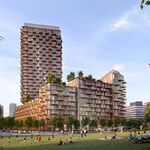A relief line along Lakeshore would be useless. The local demand can be easily handled by a new streetcar line, while the regional node that needs to be served is at King and Bay.
Also, Metrolinx wants to divert passengers away from Union, not drive more passengers to Union. See
Union Station 2031 Study. Connecting a relief line to Union would undermine this goal.
Not feasible. Downtown business areas are driven by clustering. Accounting firms want to be next to the law firms who want to be next to the finance firms.
If you want to create a second downtown, North York City Center, Scarborough Town Centre, or any number of other locations have a multi-decade head start.
Best case scenario would be a business park, perhaps one with loft-like offices rather than traditional business park wasteland.





